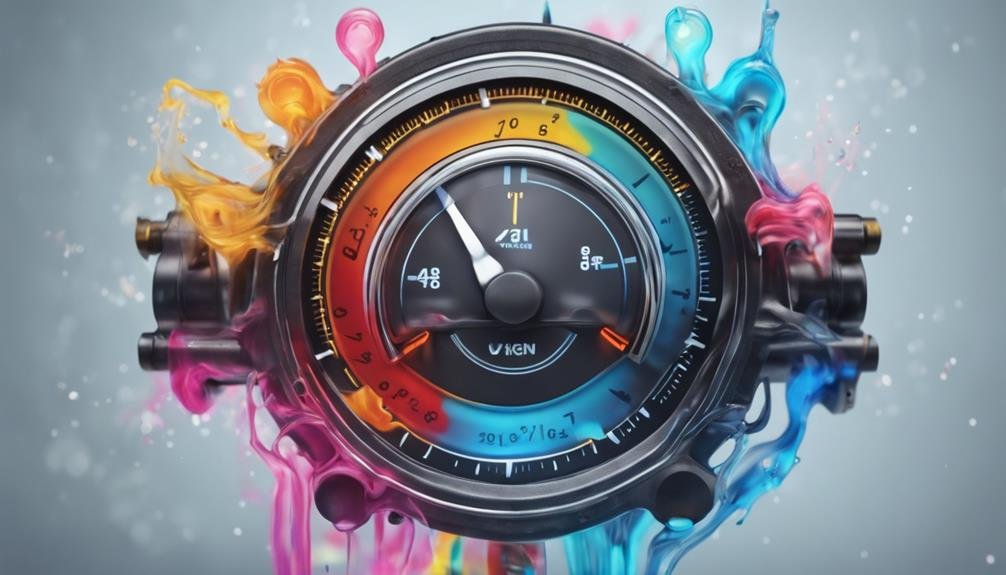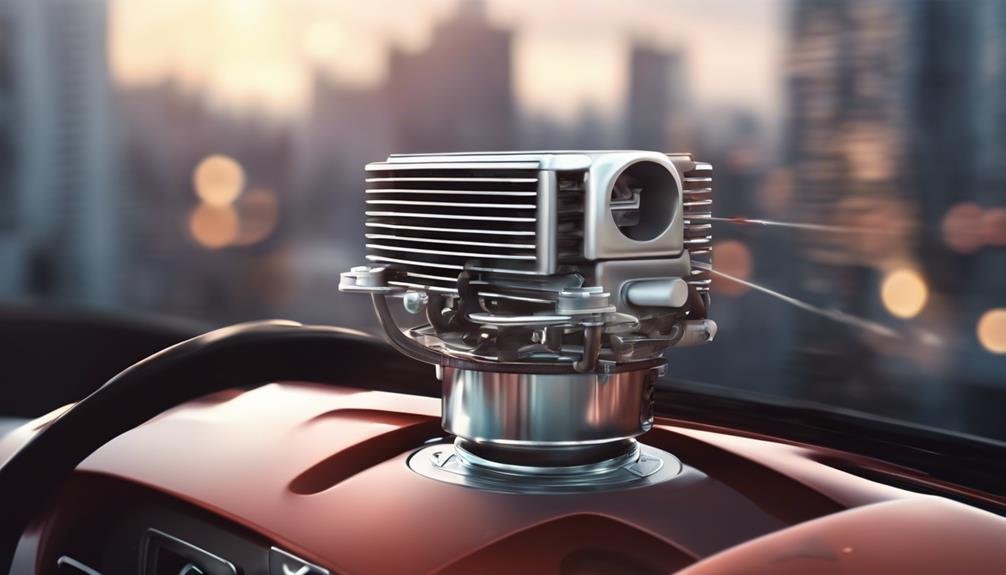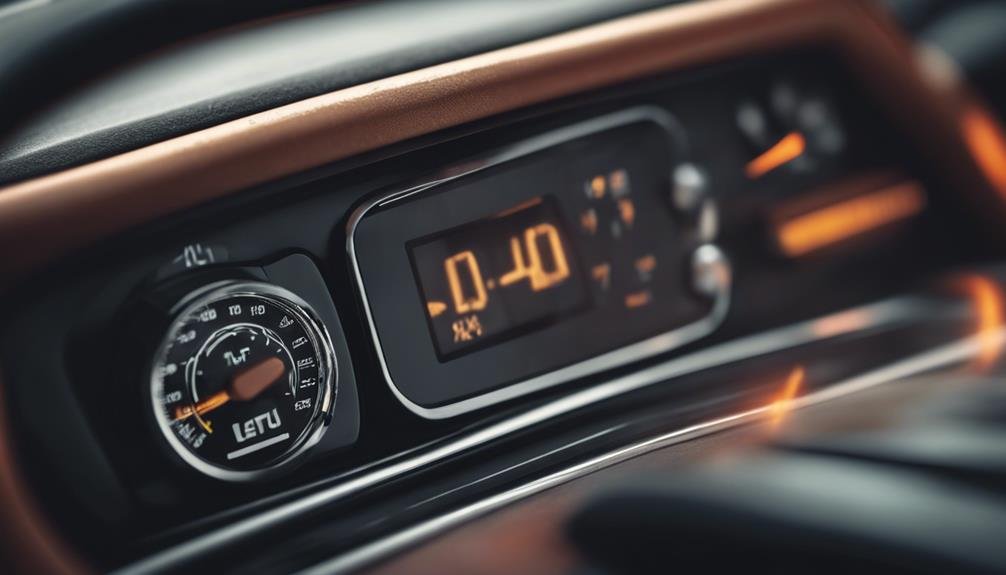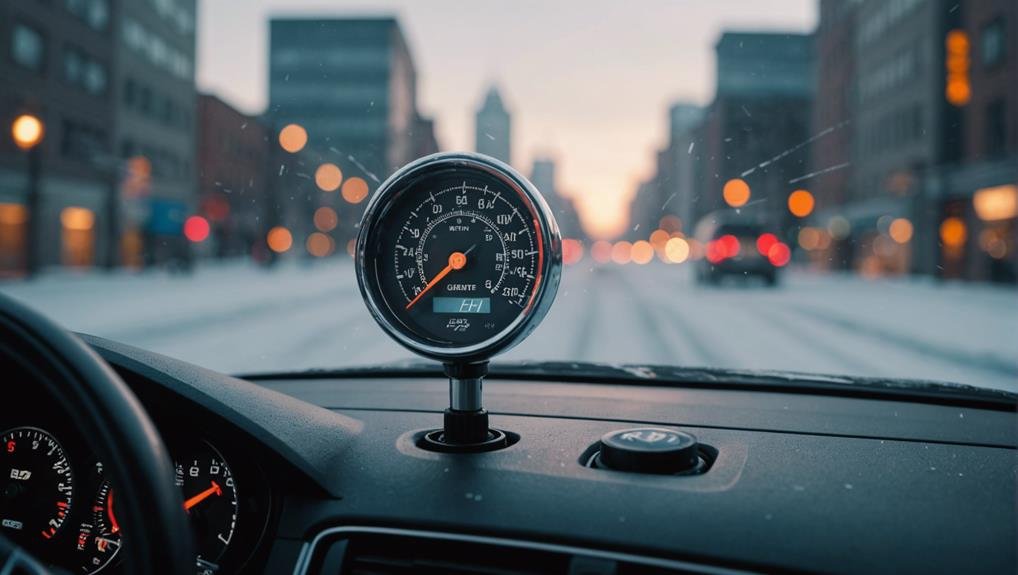When you're driving, your car's engine RPM increases, generating more heat, which is then used to warm up your vehicle's cabin, explaining why your heater often seems to only work when you're behind the wheel. As you accelerate, the engine generates more heat, and the thermostat regulates the coolant flow to maintain a warm temperature inside. This increased heat generation is what warms up your car's interior when you're driving. Want to uncover the intricacies behind your car's heating system and identify potential issues that might be affecting its performance?
Key Takeaways
- Acceleration increases engine RPM, generating more heat, which is then distributed to the heater core, providing warmth to the cabin.
- The thermostat plays a crucial role in regulating coolant flow, ensuring the ideal temperature for heat distribution.
- Inconsistent heater performance may be due to air or restrictions in the system, which can be identified through pressure testing.
- The heater control valve manages hot coolant flow, and malfunction can lead to inconsistent heating, making regular inspection and replacement necessary.
- Flushing the heater core and checking heater hose temperature can help troubleshoot heater issues, ensuring proper heat circulation.
Engine RPM and Heat Generation
As you press the gas pedal, the engine RPM rises, generating more heat that contributes to a warmer interior in your car. This acceleration triggers a chain reaction that ultimately affects your car's heating system.
With increased engine RPM, heat generation increases, which in turn activates the heater. The thermostat plays a significant role in regulating coolant flow, and with higher RPM, it may open to circulate more heated coolant for warmth.
The link between engine RPM and heat production is vital, impacting the efficiency of the car's heating system during acceleration. Consistent acceleration helps maintain a steady flow of warm coolant, ensuring a comfortable and warm cabin environment while driving.
As you accelerate, your car's engine generates more heat, which is then distributed to the cabin, making your driving experience more comfortable. The intricate relationship between engine RPM, heat generation, and coolant flow is important to understanding why your heater only works when driving.
Thermostat's Role in Heat Distribution
You depend on the thermostat to regulate the flow of coolant through the engine, which in turn affects the warmth in your car's cabin. As you drive, the thermostat plays a vital role in heat distribution, making sure that your heater function operates effectively.
Here's how it works:
- The thermostat opens and closes based on engine temperature, affecting the circulation of warm coolant.
- A malfunctioning thermostat can lead to inconsistent heat output in the car's cabin.
- Proper thermostat function is critical for maintaining ideal operating temperature and consistent heat distribution.
- Regular maintenance and timely replacement of a faulty thermostat can help restore consistent heat distribution in the vehicle.
When the thermostat functions correctly, it allows the engine to reach and maintain an ideal temperature, which is necessary for the heater to work efficiently. A malfunctioning thermostat can disrupt this process, resulting in inconsistent heat output.
Coolant Flow and Engine Performance

When you accelerate, the increased engine RPM generates more heat, which contributes to a warmer interior, and this process is closely tied to coolant flow and engine performance.
As you step on the gas, the engine RPM increases, producing more heat that's distributed throughout the car. This heat is a byproduct of the engine's increased workload, and it's regulated by the thermostat, which guarantees the coolant flows smoothly.
During acceleration, the thermostat opens, allowing more heated coolant to circulate and provide warmth to the cabin. A faulty thermostat can hinder this process, leading to inconsistent heat distribution.
To troubleshoot heater issues, it's crucial to examine the heater control valve, which regulates the flow of warm coolant to the heater core. By checking coolant levels, replacing a malfunctioning thermostat, and performing a heater core flush, you can restore consistent heat in your car.
Heater Core Function and Maintenance
The heater core, an important component in your car's heating system, radiates heat to warm the interior of your vehicle, making regular maintenance pivotal to guarantee proper functioning and efficient heat distribution.
As you drive, the heater core plays a crucial role in maintaining passenger comfort by circulating warm air throughout the vehicle. However, a clogged or malfunctioning heater core can result in poor heat output or no heat at all, leading to discomfort for you and your passengers.
To make sure of optimal heat circulation, it's necessary to perform regular heater core maintenance. Here are some key takeaways:
- Flushing the heater core helps remove debris and improve heat output.
- Regular maintenance can prevent heater core issues that affect passenger comfort.
- A well-maintained heater core ensures efficient heat distribution throughout the vehicle.
- Neglecting heater core maintenance can lead to reduced heat output and decreased passenger comfort.
Acceleration and Heat Circulation

As you step on the gas, the engine's increased RPM generates more heat, which contributes to a warmer interior when driving. This is because acceleration increases engine RPM, generating more heat that contributes to a warmer interior when driving. Pressing the gas pedal causes the engine to generate more heat, which in turn activates the heating system.
| Acceleration | Engine RPM | Heat Generation |
|---|---|---|
| Increases | Increases | Generates more heat |
| Consistent | Higher | Warmer interior |
| Forces thermostat | Opens up | Allows heated coolant circulation |
The thermostat regulates coolant flow, opening up to allow heated coolant to circulate more during acceleration. Higher RPM during acceleration forces the thermostat to open, providing warmth to the car's cabin. Consistent acceleration helps maintain a steady flow of warm coolant, ensuring a comfortable driving experience. This is why your heater only works when driving – the combination of acceleration and heat generation creates the perfect conditions for warm coolant flow.
The Importance of Regular Servicing
You can guarantee your car's heating system runs smoothly by sticking to a regular servicing schedule. This guarantees that all components, including the thermostat and heater core, are functioning properly. Regular maintenance can prevent issues like air pockets or coolant leaks that may affect heat distribution.
Here are some benefits of regular servicing for your heating system:
- Prevents blockages or obstructions that may be causing the issue
- Prolongs the life of the heating system components
- Ensures consistent and reliable heat in the car
- Improves general comfort and driving experience, especially during colder months
Diagnostic Steps for Heater Issues

To identify the root cause of your heater's malfunction, start by checking the coolant level and performing a pressure test to detect any leaks that might be affecting heat distribution. This is an important diagnostic step, as low coolant levels or leaks can greatly impact heat circulation.
| Diagnostic Step | Description | Purpose |
|---|---|---|
| Check Coolant Level | Verify coolant levels are within the recommended range | Guarantee proper heat distribution |
| Perform Pressure Test | Identify any leaks in the system | Detect potential sources of heat loss |
| Inspect Thermostat | Verify proper functioning of the thermostat | Regulate engine temperature and heat output |
| Back Flush Heater Core | Remove blockages hindering heat circulation | Restore proper heat flow |
| Verify Hot Water Bypass Valve | Ensure proper operation of the valve | Regulate heat flow to the heater core |
Common Causes of Inconsistent Heat
Inconsistent heat in your car's heater is a frustrating problem that's often linked to a handful of common culprits. As you troubleshoot the issue, it's crucial to take into account the most likely causes of inconsistent heat.
- Low coolant levels or leaks can prevent your heater from working properly, leading to inconsistent heat.
- A faulty thermostat or clogged heater core may be the reason for heat only working when driving.
- Obstructions in the heating system or a malfunctioning hot water bypass valve can also lead to inconsistent heat.
- Air in the system or restrictions in the flow can affect the heater's performance, causing heat to only work when driving.
Heater Control Valve Inspection

Your heater's performance depends heavily on the proper functioning of its control valve, which regulates the flow of hot coolant to the heater core.
This valve plays a critical role in controlling the temperature inside your car by managing the amount of hot coolant entering the heater core.
A malfunctioning heater control valve can lead to inconsistent heating in the cabin, causing the heater to only work when driving.
To guarantee proper functioning, inspect the heater control valve for any leaks, blockages, or mechanical issues that may be affecting its ability to regulate the flow of hot coolant.
Check for signs of wear and tear, corrosion, or mineral buildup that could be hindering its performance.
If you find any issues, consider timely replacement of the faulty valve to restore consistent heating operation in your vehicle.
Proper maintenance and replacement can help prevent inconsistent heating and ensure your cabin temperature remains comfortable.
Solving the Heater Conundrum
When you're stuck with a heater that only works when driving, it's time to dig deeper and pinpoint the root cause of the issue.
The heater's inconsistent performance might be due to air in the system or a restriction causing the problem. To troubleshoot, you'll need to pressure test the system for integrity and perform flow testing on the heater core to identify the root cause.
Some key areas to focus on include:
- Verifying proper flow by checking the temperature of heater hoses
- Inspecting the head gasket for signs of failure, which can introduce air into the cooling system
- Performing maintenance and troubleshooting to make sure consistent warmth in the cabin while driving
- Conducting flow testing to identify any restrictions in the system
Frequently Asked Questions
Why Does My Car's Heater Blows Cold Air When Stopped?
You're probably wondering why your car's heater blows cold air when stopped – it's likely due to low coolant levels, a faulty thermostat, or a clogged heater core, which you can diagnose and fix with some troubleshooting and maintenance.
Why Does My Heat in My Car Only Work When I Accelerate?
When you accelerate, your engine RPM increases, generating more heat, which the thermostat regulates, circulating warm coolant, and providing warmth to your car's cabin; this is why you feel heat only when you accelerate.
Why Does My Car Heat Go Cold When Idling?
When your car's heat goes cold while idling, you're likely dealing with a restriction in the heating system, low coolant levels, or a malfunctioning thermostat, which you can diagnose by checking radiator and heater core pressure.
Why Does My Car Heater Only Work on the Driver's Side?
You're wondering why your car heater only works on the driver's side, right? It's likely due to a faulty blend door actuator, clogged heater core, or malfunctioning temperature control module, which you can diagnose using a scanner or consulting your car manual.
Conclusion
As you've now grasped the intricacies of your heater's operation, it's clear that a combination of factors, including engine RPM, thermostat function, coolant flow, and heater core maintenance, influence its performance.
By understanding these components and their interactions, you're better equipped to diagnose and address issues, ensuring consistent heat when you need it, whether driving or idling.
